Fragrance Ingredients list was my long pending agenda since, I enjoyed an experience of making a scent for myself. Roughly, my perfume looked something like this layered bunch of essences (If you have any passion for trying fragrances, you must try the bunching of essences like the below):
Top Notes (Oils): Bergamot (5 drops), Wild Orange (3 drops), Neroli (5 drops),
Middle Notes (Oils): Rose (6 drops), Lavender (10 drops), Blue Chamomile (3 drops), Geranium (8 drops)
Base Oils (Oils): Vanilla (I used 1 tsp of my homemade vanilla extract for this), Cedarwood (3 drops), Vetiver (4 drops), Ylang Ylang (3 drops), Sandalwood (4 drops), Frankincense Oils (8 drops)
In fact, my honest confession would be that, methodology is representative of making of any perfumes/Attar. And, if you change the ingredients final product (Attar/Perfumes) would change. One prevailing misconception though, you need to correct is that essential oils are the only basic ingredients of fragrances. Matter of fact is that there are many kinds of ingredients other than essential oils which make of perfumes. You must not wonder that the best attar and the best perfumes use many other fragrant ingredients apart from essential oils.
Essential Oil is Only a Kind of Raw Fragrant Materials in Perfumery
Yes, essential oils are only a kind of raw fragrance that is used to make perfumes, colognes and attar. There could be a variety of fragrant essences that are used in the perfumery. In fact, the variety in essences are the result of modality of extraction that you employ in extracting them. The most basic method of extraction, steam distillation is not be suitable for extraction in all cases. Accordingly, by altering the methodology, a variety of essences and by-products are resulted. Best attar names on market place use more than one essences that you can obtain by various methodology of extractions.
Essential Oils their Extraction and Usefulness in Perfumery
The essential oil is most common term that you use for fragrance and flavor extracts. However, this is only one of the different possible extracts. Basically, essential oils are a product derived simply through distillation or the application of pressure (cold pressing). Under distillation, you put organic matter such as flowers, leaves, seeds and bark through steam distillation treatments to separate out the volatile essential oils. While, under the cold pressing extractions, rinds are perforated and squeezed to release the oil. Essential Oils are the foremost core essence that mankind has been using since beginning. Foremost list with best attar names started with use of essential oils.
Concretes and Their Extraction and Usefulness in Perfumery
Steam distillation, in some instances can destroy the essences organic in nature, because of heat. Solvent extraction is the way to go in these cases. It uses hydrocarbons (such as hexane) to extract the volatile compounds without degrading them in the process. Once, you remove the solvent, the resulting product is known as a concrete. And, the product so obtained contains the volatile aroma molecules along with chlorophyll and other plant tissues. As a result, you get a highly colored and viscous extract. Because of viscosity, Concretes also tend to be far less volatile than essential oils and find use as fixative of a fragrance. And, these fixatives form ingredients of some of the best attar names to release aroma for a longer time.
Absolutes their Extraction and Usefulness in Perfumery
Absolutes are next tier derivation of concretes which results in when concrete is subjected to further round of solvent extraction using ethanol etc. In the process, the solids (waxes, oils, fats, etc) dissolve in the alcohol. Alcohol is then removed through process of evaporation. The resulting “essence” is termed as absolute and it is the most concentrated form of fragrant essences. Absolutes are even more stable than concretes and find use as superior fixative in fragrances. Few best attar names on the market make use of absolutes to offer you enduring aroma.
Absolutes differ from essential oils in that they contain not only essential oil, but also coloring, waxes and other constituent integral to the plant. Usually, they contain a small percentage of alcohol also absorbed during tier II extraction (as low as 1- 3 %). Obviously, absolutes are most potent raw ingredients for fragrances as their concentration is extremely high.
Resinoids- their Extraction and Usefulness in Perfumery
When you apply same extraction process with natural resins and gums as for concretes, you happen to get resinoids. Natural resins are available under many names such as balsams, gum resins, and natural oleoresins. When you extract essences from them by using hydrocarbon solvents you get Resinoids. The resulting product possesses non-volatile stable organic essences. Like concrete and absolutes, they too have wide use as fixatives for enduring aroma in a fragrance.
Amber- The Fossilized Resin and Use in Perfumery
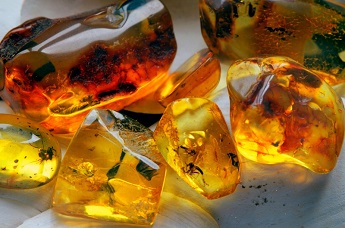
Amber usually marketed today are not the original Amber resins. Original Amber resins are basically fossilized Resins and are gemstones. They can be mined from sea or coal seams or basically from cretaceous age rocks. Originating from trees of pine genus they took thousands of years to evolve as beautiful gemstone.
The marketed Amber in todays’ market are imitations by crystalline substances made of resins like copal and kauri gum sometimes also by celluloid and even glass.
The amber very rare in availability are used as fixative for long enduring fragrances and fragrant pendants. Perfumery usually cannot afford to use Real Amber so, they use ingredients of Amber family, i.e, different resinous ingredients. Since Resins are precursor of Amber, hence amber family.
The Ambergris and Uses in Perfumery
Ambergris are commonly known as grey Amber, although it is not the Amber. Physically, Ambergris is a grey to black, flammable substance and its production occurs in the gut of the sperm whale. The Ambergris are rarely seen floating in sea water. They are very pricey on account of their rare occurrence and they have found medicinal, aphrodisiac and fragrant usage in olden times.
Since, natural ambergris are rare, they are very expensive. Therefore, current perfumery uses synthetic substitutes of Ambergris. Modern perfumery makes use of ambrein, epicoprostanol/coprostanone and ambrox/ambroxane to make perfumes with Ambergris Note. Ambergris are highly rated fixative for perfumes that allow the scent to last much longer. Ambergris Fragrances are identified by notes like (i) Caramel & Tobacco (ii) Sweet, woody & Musky and (iii) Animalistic & Salty. Few of perfumes of ambergris family featuring sweet, animalistic and salty facets of ambergris are here:
- Ambre Russe, Classique, Quel Amour having Ambrien
- D&G Light Blue, Calypso, Portrait of a lady having Ambroxan
- Eau des Merveilles, Muscs Kublai Khan featuring Salty aspect
Resins & Natural Gums as Early Source of Fragrance
The early civilization in their search for fragrances focussed on to resins like myrrh, frankincense, pine, fir, agarwood, and balsams. In all likelihood, the civilization discovered these fragrance items once the resins were burnt and intense pleasing smell entered their lungs.
On the face, Resins are tears that weeps out from the wounds in trees. And, commercially they are produced by cutting an incision in a tree and collecting those tears (resin) from the bark.
Resins were the source of early perfumes and their long-lasting aroma make them best fixatives available naturally. So, early perfumes and modern best attar names claiming to be natural use them for offering you long lasting fragrance.
Incense Group of Fragrances
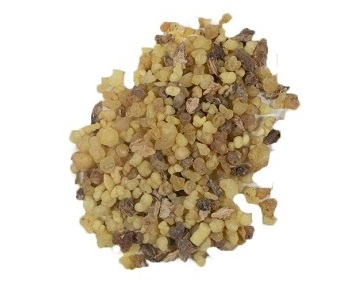
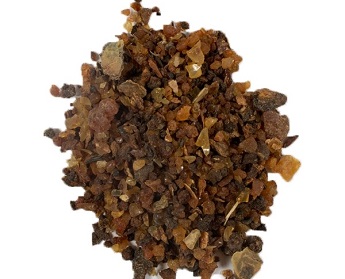
The incense group of perfumes for most part, make use of these resins. Incense type perfumes are often thought of as heavy, dark and spicy.
Frankincense however, is a common incense ingredient that can provide a light, lemony base that beautifully complements citrus or floral perfumes. Frankincense is peppery, lemony, and slightly reminiscent of varnish on a wooden floor.
Myrrh can be described as woody, warm, sweet, but also dark, slightly medicinal, even anisic. You might love the richness Myrrh adds to a strong perfume.
Balsam Group of Fragrances
Balsam fragrances are another resin and stand for a sweet, nearly vanilla, rich and cinnamic fragrance. They may come from several different plants and include Peru balsam, tolu balsam, styrax balsam amber and benzoin.
The term balsamic is often used generically to describe a rich, heavy, sweet, woody and incense note. Despite this similarity in descriptions, the different balsams can be best used for different purposes. Each kind of balsam has its own character and can enrich floral, green or woody perfumes. Peru balsam is quite sweet, just a bit spicy, and really enhances a vanilla or amber accord. Styrax benzoin is great for smoky, leathery, intense perfumes and Tolu is of similar character. Styrax is a little harder to work with, than Peru balsam and tends towards the dark, leathery, and rich.
Benzoin, labdanum and amber are other resins, and are great all-purpose sweet vanilla balsam that is used in a variety of perfume types and is a great fixative for many blends.
Amber group of fragrances
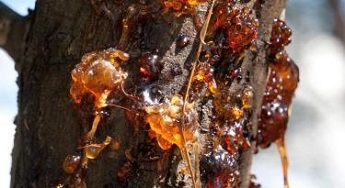
Unless you have ambergris or fossilized amber oil, both very uncommon, the amber in fragrance is a misnomer. So, lets face the reality. Amber fragrances are a blend of resinous scent rather than one single aroma from real Amber.
Amber notes are a sweet, woody earthy note from blends of various resins. The perfumers defines the amber note this way possibly because resins are the precursor to amber.
The Amber resins are mostly a solid crystalline fragrance made from a combination of many resinoids and oleoresins (spice plant extracts). Labdanum resin is the most popular Amber fragrance ingredient. Other Amber resins are benzoin, balsam of peru, frankincense, myrrh, copal, styrax/storax/liquidambar. An Amber fragrance would use oils also such as cedarwood, sandalwood, and vanilla.

Crystalline Resins and Uses
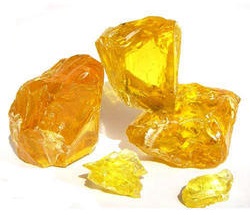
Crystals of natural pine resin, Gum Rosin is widely used as a tackifier and ingredient in adhesives. It can be added to waxes to give stickiness and adhesion. It can also be used as a lather-enhancer in soaps and can be added in modest quantities to melted oils and fats when making natural soaps.
Crystals of natural myrrh gum can be ground to powder and added to soaps. Also, they can be used traditionally as fragrant incense in a suitable burner.
Crystals of natural frankincense gum can be ground to powder and added to soaps. Also, they can be used traditionally as fragrant incense in a suitable burner.
Ceremonial Use & Therapeutic Values of Resins
Some resins have got links with religious or ceremonial purposes and burned in holy places. Myrrh & Frankincense are mostly burned for sacred purposes. Few others had to do with death rituals as they were used in embalming the dead bodies by the early Egyptians. There are evidences to show that Egyptians were the creators of early perfumes.
Resins and balsams also find use as skin healing medicines.
Organic Extract as Raw Ingredients to Make Perfume
They are bio-available essences and able to captures the intricate aroma of the original plant material. These oils find best use for body care and aromatherapy due to the ‘aliveness’ of the essences. Moreover, the natural perfumers who wish to create organic fragrance also rate them best.
Similar to absolutes, organic extract – also called by its French name, extrait – is derived by way of a solvent extraction process. However, the difference is that only benign solvents are used in the process. The resulting essence is usually softer and less intense than conventional absolute obtained with help of hexane. Because of benign solvent having been used in the process they are certified as an organic product.
With concept of Green Chemistry on rise, environmentally benign substitutes for toxic organic solvents has picked up greater attention. Traditional Organic solvents are not only toxic, they are also highly flammable, volatile, and hazardous. Accordingly, Super-critical fluids (most popular one scCO2), Ionic Liquids (ILs), low melting polymers (especially PEG), per-fluorinated solvents, natural oils, Glycerine, Vinegar and water are making way to benign solvents.
Aroma Chemicals and Their Use in Perfumery
Aroma chemicals are aromas synthesized in chemical laboratory. Today big number of perfumes on the market make use of aroma chemicals. Whereas only a small number of bespoke perfumes, use only natural ingredients.
Use of Aroma Chemicals however is not only to offer you perfumes at competitive prices. In fact, Aroma chemical throw up a very wide spectrum for smells as opposed to natural ingredients available easily. With synthesizing of aroma chemicals, it is possible to make perfume of almost any smell. Aroma chemicals, further let to experiment various combinations of tweaking in the fragrances using with natural ingredients.
Perfumers blend aroma chemicals in certain ratio to create a perfume formula. Usually, a perfume formula has 6 up to 60+ aroma chemicals in the formula. You must not wonder that aroma chemicals can be used for formulating smells of baked goods, drinks, candy, alcohol, etc. First Aroma chemical used was aldehydes. But as on date there are thousands of aroma chemicals available for making the perfume formula unique. Individually, aroma chemicals are bits and pieces of a fragrance, that make up unique perfumes and flavours.
Even best attar names and the Fragrances today cannot go about without using Aroma chemicals by certain percentage.
Pheromones as an Ingredient to Perfumery
This ingredient forming part of some of the high end perfumes has a controversial effect but recent studies endorse their importance.
Pheromones are naturally occurring chemicals that send out subconscious scent signals to the opposite sex that trigger very powerful sexual responses.
Lets see what authoritative sources speak about Pheromone.
McCalls’s magazine: “Pheromones can Improve one’s sex life, pheromones send out subconscious signals to the opposite sex that naturally trigger romantic feelings.”
The Los Angeles Times: “Scientific studies have actually shown that subjects who used synthesized pheromones had sex more often.”
CNN: “The power of smell is undeniable humans are Influenced by airborne chemicals undetectable as odors, called pheromones. Researchers at the University of Chicago say they have the first proof that humans produce and react to pheromones.”
Wikipedia: “Androstadienone, also known as androsta-4,16,-dien-3-one, is a chemical compound that has been described as having strong pheromone-like activities in humans.”
University of California: “Just a few whiffs of a chemical found in male sweat is enough to raise levels of the stress hormone cortisol in heterosexual women, according to a new study by University of California, Berkeley, scientists.”
WebMD: “Pheromones, those mysterious, scentless chemicals that some say drive human sexual behavior, have been studied for decades. But now researchers say they’ve finally found proof that mammals — such as humans and mice — are actually programmed to detect and use them.”
Comprehensive list of Ingredients Making Perfume
Given the fact, that there are whole lot of Ingredients to make perfume or fragrance in general. All sources are not equally dependable. Individually they supply the ingredients to meet your case specific needs.
1. Essential Oils as Most common Ingredient to Make perfume
Many companies are there in market place which offer you a wide variety of essential oils. These include essential oils of different qualities and grades of oils to match your specific needs. Grading could be pure & natural, natural, and commercial as well.
Originally, Essential oils are very potent having strong smells and using them in original form may cause skin or health issues. So, they are mostly mixed with other natural oils to dilute their Potence and make them suitable for applying on body parts. With proper dilution (However, sometimes without dilution) they can be used as organic perfume oil, body oil, scented oil and aromatherapy oil. The best attar names out there claim using one or many of the essences below.
| Alphabets | Essential Oils |
| A | Agrumes Terpenes, Almond Oil Sweet, Almond Oil Bitter, Ambrette Seed Oil, Amyris Oil, Angelica Leaf Oil, Angelica Root Oil, Angelica Seed Oil, Aniseed Star Oil Chinese, Aniseed Star Oil High Terpenes, Aniseed Oil Terpeneless, Armoise Oil, Armoise Oil Extra P&N, Asafoetida Oil, Avacado Oil |
| B | Balsam Fir Oil, Balsam Oil, Basil Oil, Basil Oil Linalool type, Basil Oil Methyl Chavicol type (Sweet), Bay Oil, Bergamot Oil, Bigarade Phase FCR, Black Pepper Oil, Buchu Oil |
| C | Cabreuva Oil, Cade Oil, Cadjeput Oil, Calamus Oil, Calendula Oil, Cananga Oil, Camphor Oil White 35%, Caraway Seed Oil, Cardamon Oil, Cardamon Bark Oil, Carrot Seed Oil, Cascarilla Bark Oil, Cassia Oil, Catnip Oil, Cedarleaf Oil, Cedarwood Chinese, Cedarwood Crude, Cedarwood Oil Atlas, Cedarwood Oil Extra, Cedarwood Redistilled, Cedarwood Texas,
Cedarwood Virginia, Cedarwood Oil Himalayan Pure, Celery Leaf Oil, Celery Seed Oil, Chamomile Oil Blue (Egyptian), Chamomile Morocco (Savage) Oil, Chamomile Oil Roman, Chamomile Water, Cinnamon Bark Oil, Cinnamon Leaf Oil, Citronella Oil, Citrus Paradisi Oil, Clary Sage Oil, Clementine Oil, Clementine Phase Oil, Clove Bud Oil, Clove Leaf Oil, Clove Stem Oil, Coconut Oil, Coffee Oil Roasted, Cognac Oil Green, Cognac Oil White, Cornmint Oil, Cornmint Oil Triple Distilled, Cornmint Oil Crude, Copaiba Balsam, Coriander Leaf/Herb Oil, Coriander Seed Oil, Coriander Seed P&N, Coriander Herb Oil, Cumin Seed Oil, Cypress Oil |
| D | Davana Oil, Dillseed Oil |
| E | Elemi Oil, Eucalyptus Citriodora, Eucalyptus Dives, Eucalyptus 70/75, Eucalyptus 80/85, Eucalyptus Globulus Oil Organic, Eucalyptus Oil Organic,
Eucalyptus Radiata |
| F | Fennel Seed Oil Sweet, Fennel Oil Bitter |
| G | Galbanum Oil, Geranium Oil Bourbon, Geranium Oil Chinese, Geranium Oil Egypt, Ginger Oil, Ginger Oil CO2, Grapefruit Phase Oil, Grapefruit Oil, Grapeseed Oil, Guaiacwood Oil, Gurjum Balsam, Gurjum Balsam Rectified |
| H | Hops Oil, Ho Leaf Oil, Ho Wood Oil, Hyssop Oil |
| Immortelle (Everlasting) Oil | |
| J | Jojoba Oil, Juniper Oil, Juniperberry Oil |
| L | Labdanum Oil, Laurel Bay, Laurel Leaf Yugo, Laurel Leaf Oil, Lavandin Abrialis Oil, Lavandin Grosso Oil, Lavender Oil, Leek Oil, Lemon Oil, Lemon Verbena, Lemongrass Oil, Lime Oil, Litsea Cubeba Oil, Lovage Leaf Oil |
| M | Mace Oil, Mandarin Oil, Marjoram Oil, Melissa Oil, Myrrh Oil, Myrtle Oil |
| N | Neroli Oil, Nutmeg Oil, |
| O | Olibanum Oil, Onion Oil, Opoponax Oil, Orange Oil, Origanum Oil,
OTBCHA |
| P | Palmarosa Oil, Parsley Leaf Oil, Parsley Seed Oil, Patchouli Oil,
Patchouli Oil Crude, Patchouli Oil Dark, Patchouli Oil Light, Patchouli Oil MD, Peppermint Oil, Petitgrain Bigarade Sur Fleurs Egypt, Petitgrain Bigarade Leaf & Twig, Petitgrain Oil Citronnier, Petitgrain Oil Mandarinier, Pimento Berry Oil, Pimento Leaf Oil |
| R | Rose Oil, Rosemary Oil, Rosewood Oil (Bois de Rose) |
| S | Sage Oil, Sandalwood Oil, Spearmint Oil, Spruce Oil, Styrax Oil, Sunflower Oil |
| T | Tagette Oil, Tangerine Oil, Tansy Oil Blue, Tarragon Oil, Tea Tree Oil , Thyme Oil |
| V | Verbena Oil, Vetivert Oil, Vetivert Terpenes |
| W | Wintergreen Oil |
| Y | Ylang Extra, Ylang I Oil, Ylang II Oil, Ylang IIIOil |
Quality of essential oils can vary. You may note that same species of plant grown in different climatic zones can acquire little varying properties. Thus, depending on the season, climate, or growing conditions of a plant, the chemical components of an essential oil would vary. Therefore, it becomes difficult for fragrance craft makers to keep quality of their finished products consistent across geographic zones.
2. Absolutes/Concretes/Resinoids
A wide variety of absolutes, concretes and resinoids are also available in the market place and each of the companies offer them in multiple combinations of grade.
| A | Ambrette Seed Absolute Extra |
| B | Basil Absolute Methyl Chavicol, Beeswax Absolute, Benzoin Resinoid, Benzoin Hyper Absolute, Black Currant Absolute (Bourgeons de Cassis),
Black Pepper Absolute, Bran Absolute, |
| C | Cacao Absolute, Carrot Seed Absolute, Cassie Absolute, Castoreum Abs,
Clary Sage Absolute Green, Clove Bud Absolute, Cocoa Absolute, Coriander Absolute, |
| E | Elemi Resinoid, Elemi Resinoid Pure, Elderflower Absolute |
| F | Frangipanni Absolute |
| G | Galbanum Resinoid, Genet Absolute |
| H | Hay Absolute, Hazelnut Absolute, Hyacinth Absolute |
| I | Immortelle Absolute |
| J | Jasmine Absolute Indian, Jasmine Absolute Italian, Jasmine Absolute Egyptian |
| L | Labdanum Absolute, Lavandin Absolute, Lavender Absolute, Lovage Root Absolute |
| M | Marigold Absolute, Marigold Absolute Decolorized, Mate Absolute, Mimosa Absolute, Myrrh Resinoid |
| N | Narcisse Absolute, Nutmeg Absolute |
| O | Oakmoss Absolute, Olibanum Resinoid, Orange Flower Absolute, Orris Concrete, Osmanthus Absolute |
| P | Patchouli Absolute |
| R | Rose Absolute |
| S | Spinach Absolute, Styrax Gum/Styrax Resinoid |
| T | Thyme Absolute, Tolu Balsam Resin, Tonka Beans Absolute |
| V | Vanilla Absolute, Violet Leaves Absolute |
3. Aroma Chemicals
Aroma chemicals either synthetic OR natural are instrumental in shaping the desired fragrance of a fragrance oil.
| A | Aldehyde C14, Aldehyde C8, Aldehyde C16, Aldehyde C11, Allyl Amyl Glycolate, Allyl Caproate, Allyl Heptanoate, Allyl phenoxyacetate, Alpha Amyl Cinnamaldehyde, Ambrettolide, Anethole Natural, Anethole Synthetic USP, Anisic Aldehyde, Anisyl Acetate, Anisyl formate |
| B | Benzyl Acetate, Benzyl Alcohol, Allyl Caproate Natural, Benzyl Alcohol Natural, Benzyl Benzoate, Benzyl Isobutyrate, Benzyl Iso Eugenol, Benzyl Phenylacetate, Benzyl Salicylate, Bergamot Synthetic, Beta Pinene, Borneol, Bornyl acetate, Butyl Benzoate, Butylated Hydroxy Toluene |
| C | Camphor Powder USP (Flakes), Camphor Powder DB6 & DB8, Camphor Natural, Carvone – D, Carvacrol, Beta Caryophyllene, Cedryl Acetate, Cedryl Methyl Ether, Cedryl Methyl Ketone, Cinnamic Aldehyde,
Cinnamonitrile/Cinnamyl Nitrile, Cinnamyl cinnamate, Citral Natural, Citral Synthetic, Citrolime (Dihydromyrcenol Rectified), Citronellyl acetate, Citronellyl acid, Citronellyl formate, Citronellyl nitrile, Coumarin, Coumarin Natural, Cycloctal / Octanal glycol acetal, Cyclododecyl formate, Cyclohexyl Acetate, Cyclomugual |
| D | delta-Damascone, Decyl Nitrile (Lauryl Nitrile), Decyl Aldehyde,d-Limonene (97% Distilled Limonene), d-Limonene High Purity Stabilized/Protected, Dicyclopentadienyl Acetate, Diethyl adipate,
Diethyl phthalate, Diethyl Tartrate, Dihydro Isojasmone, Dihydro Citronellyl Nitrile, Dihydromyrcenol, Dihydro Eugenol, Dihydroterpineol, Dimethyl anthranilate, Dimethyl heptanol, Dimyrcetol, Dioctyl adipate, Dioctyl phthalate, Dipentene, Dipentene 0.01% BHT, Diphenyl oxide, Dipropylene Glycol Fragrance Grade |
| E | Ethyl Dimethylhydrocinnamal, Ethyl Amyl Ketone, Ethyl Caprate, Ethyl cyclogeraniate, Ethyl Geranate, 2-Ethyl-1-hexanol, Ethyl 2-hexenoate,
Ethyl Isobutyrate, Ethyl levulinate, Ethyl Linalool, Ethyl Linolenate, Ethyl Maltol, Ethyl Myristate, Ethyl 2-Methyl Butyrate, Ethyl 2-Methylpentanoate, Ethyl Myristate, Ethylene Brassylate, Ethyl Tartrate, Ethyl Vanillin, 3-Ethoxy-4-hydroxybenzaldehyde, Eucalyptol |
| F | Fenchyl alcohol, Fenchone |
| G | Gamma Decalactone, Geranic Acid, Geraniol Fine FCC, Geraniol ex Citronella (Geraniol Natural), Geraniol Synthetic, Geranyl Butyrate, Geranyl Formate, Geranyl Nitrile, Geranyl Tiglate, Glycolierral, Greenyl Acetate (Cyclacet), Guaiacwood Acetate |
| H | Heliotropine, Heliofresh, Heliotropine Acetone, Heptoxime, Hercolyn-D,
Hexyl Butyrate, Hexyl Cinnamic Aldehyde, Hexyl Salicylate, Hydroxy Citronellal |
| I | Indole
Ionone Alpha, Ionone Beta, Ionone 100%, Isoamyl Alcohol, Isoamyl isovalerate, Isobornyl Acetate, Isoamyl Benzoate, Isoamyl butyrate, Iso E Super (Amber Fleur), Isobutyl benzoate, Isobutyl isobutyrate, Isoeugenol, Isobutyl salicylate, Isomenthone, Isononyl Acetate, Isopar, Isopropyl Methyl-2-Butyrate, Isopulegol, Ivyal |
| J | Jallione (Mangone/ Pulegone Mercaptan), Jaffaral |
| L | L-Carvone, L-Limonene, Lemonile, Linalool, Linalyl Acetate, Linalyl isobutyrate, Linalyl propionate, Lovage Root Oil, Lyral |
| M | Maple Lactone, Melonal, Menthol Block, Menthol Crystals Chinese,
Menthol Crystals Indian, Menthol Flakes FCC Synthetic, Menthol FCC Synthetic, L-Menthone, Methyl Beta Naphthyl Ketone, Methyl Chavicol, Methyl D.H.-Jasmonate, Methyl heptyl ketone, Methyl Eugenol, Methyl 2-hexenoate, Methyl hexyl ketone, Methyl Ionone Gamma, Methyl Ionone Alpha, Methyl Isoeugenol, Methyl linolenate, Methyl anthranilate, Methyl 3-methylthiopropionate, Methyl phenylethylether, 2-Methyl-2-pentenoic acid, Methyl Phenylacetate, Methyl Salicylate 100, Methyl Salicylate 50, Methyl Salicylate NF, Methyl Salicylate 25, Methyl Salicylate 20, Musk G 50% in DPG, Musk G 50% in BB, Musk G 50% in DEP, Musk G 50% in IPM, Musk Ketone, Musk Xylol, Myristaldehyde |
| N | Neroline Yara Yara, Nerolin Bromelia |
| O | 3-Octanol |
| P | Phenyl Acetaldehyde Dimethyl Acetal, Phenyl Ethyl Acetate, Phenyl Ethyl Alcohol, Phenylethyl Cinnamate, Phenylethyl isovalerate, Phenylethyl salicylate, Propenyl Guaethol |
| R | Raspberry Ketone, Rose Oxide |
| S | Sabinene, Sandalore, Styrallyl Propionate |
| T | Terpineol Alpha, Terpinolene 20, Terpinolene 30, Terpinolene 90, Terpinyl Acetate, Tetrahdyro Myrcenol, Thymol, Tiglic acid, Triethyl Citrate, Trivertal |
| V | Valencene 50%, Vanillin, Vanillin Natural ex Clove, Vetiveryl Acetate, Virixal nitrile |
4. Natural Extracts
You can find a range of natural extracts, some of which could be flavour grade and certified kosher too.
| A | Acai Berry Extract, Agapanthus Flower (Lily of the Nile) Extract Alfalfa Grass Extract Aloe Vera Extract Ashwagandha Extract Astaxanthin Astragalus Extract |
| B | Barley Grass Extract Beta Carotene Bilberry Extract Birch Bark Extract Bitter Orange Extract Blackberry Extract Boswellia Extract |
| C | Capsaicin Chinotto Extract Chloerlla Chlorophyll Powder Citrus Extract Coffee Extract CoQ10 Curcumin Cypress Blue Leaf Extract Cypress Blue Wood Extract |
| D | Dandelion Extract Davidson Plum Extract Desert Lime Extract |
| E | Echinacea Extract Elder Flower Extract Emu Apple (Muntries) Extract |
| F | Frangipani Flower Extract |
| G | Gardenia Flower Extract Garlic Extract Ginger Extract Ginkgo Biloba Extract Ginseng Root Extract Goji Berry Extract Grapefruit Extract Green Coffee Extract Green Tea Extract |
| H | Hawthorn Extract Hemp Seed Extract Horny Goat Weed Extract |
| I | Illawarra Flame Tree Flower Extract |
| J | Jacaranda Flower Extract |
| K | Kakadu Plum Extract Kangaroo Apple Leaf Extract |
| L | Lemon Aspen Extract Lemon Extract Lemon Myrtle Leaf Extract Lime Extract |
| M | Maca Root Extract Mace CO2 Extract Magnolia Bark Extract Mandarin Extract Mango Extract Mangosteen Extract Marigold Extract Milk Thistle Extract Mint Extract Mountain Pepper Berries Extract Mountain Pepper Leaf Extract Mulberry Extract |
| N | Nutmeg CO2 Extract |
| O | Olive Leaf Extract Orange Extract Pea Protein |
| P | Pine Bark Extract |
| Q | Quercetin |
| R | Resveratrol |
| R | Rhodiola Rosea Extract, Rose Hips Extract Rose Rugose Extract |
| S | Sea Buckthorn Extract Snake Vine Extract Spirulina |
| T | Tangerine Extract Tea Tree Leaf Extract |
| W | Wheat Grass Extract Willow Bark Extract Witch Hazel Extract Wormwood Extract |
| Y | Yucca Extract |
5. Organics
A wide range of certified organic products are also available for making flavours or fragrance oils.
| A | Angelica Root Oil Organic Anise Seed Oil Organic |
| B | Basil Oil Methyl Chavicol Organic Basil Oil Organic Basil Sweet/Linalool type Organic Bergamot Oil BF Organic Black Pepper Oil Organic Bois de Rose Organic |
| C | Caraway Seed Oil Organic Cardamon Oil Organic Cassia Oil Organic Cedarwood Oil Atlas Organic Celery Leaf Oil Organic Celery Seed Oil Organic Chamomile Oil Blue Organic Chamomile Oil Roman Organic Cinnamon Bark Oil Organic Cinnamon Leaf Oil Organic Citronella Oil Java Organic Clary Sage Oil Organic Clove Bud Oil Organic Clove Stem Oil Organic Coriander Leaf Oil Organic Coriander Leaf Oil Organic Coriander Seed Oil Organic Cumin Seed Oil Organic |
| F | Fennel Seed Oil Bitter Organic Fennel Oil Sweet Organic |
| G | Garlic Oil Organic Geranium Egyptian Organic Ginger Oil Organic Grapefruit Oil White Organic |
| H | Honey Suckle Extract Organic Hyssop Oil Organic |
| I | Immortelle Absolute Organic |
| J | Jasmine Extract Organic Juniperberry Oil Organic |
| L | Laurel Leaf Oil Organic Lavandin Oil Organic Lavender Oil Bulgarian Organic Lavender Oil Organic (French) Lemon Oil Organic Lemongrass Oil Organic Lime Oil Distilled Organic Lovage Root Oil Organic |
| M | Mace Oil Organic Mandarin Oil Organic Marjoram Sweet Organic Menthol Crystals Organic Milfoil Organic Myrtle Oil Organic |
| N | Neroli Oil Organic Nutmeg Oil Organic |
| O | Onion Oil Organic Orange Oil Organic Orange Sweet Organic Origanum Oil Organic |
| P | Palmarosa Oil Organic Parsley Leaf Oil Organic Peppermint Oil Organic Petitgrain Bitter Orange Oil Organic Petitgrain Sur Fleur Organic |
| R | Rose Centifolia Extract Organic Rosemary Oil Organic |
| S | Sage Oil Organic Sandalwood Oil Organic Spearmint Oil Organic |
| T | Tagette Oil Organic Tea Tree Oil Organic Tumeric Oil Organic |
| V | Vetivert Oil Organic |
| Y | Ylang Oil Complete Organic Ylang Extra Organic |
Check the Top Perfume Brands Which Always Make Best in Class Fragrance Ingredients!

Be the first to comment